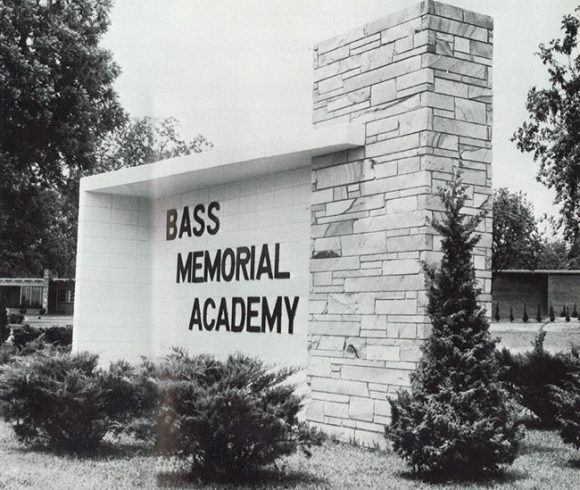History
Bass Memorial Academy
Is a regionally and denominationally accredited, co-educational boarding high school operated by the Gulf States Conference (Alabama, Mississippi and N.W. Florida). The academy is located on 436 acres in Lamar County, Mississippi between the small towns of Lumberton and Purvis. Bass Christian Elementary School (Grades 1-8) is located on campus.

1963
The story of how BMA was founded and how it came to be at its particular location is both interesting and remarkable. Indeed, the details of the account serve to validate the opinion of many constituents and alumni that God’s hand was clearly evident in the founding of the academy. The roots of K-12 education on this spot trace back the early 1900s to the tiny community of Talowah, Mississippi, which is located about two miles south. Records show that the first Seventh-day Adventist was a nurse and colporteur, J.L. Waller, who believed the area would be an excellent place for a school, church and sanitarium. By 1922 a church was organized and a school was formed that eventually grew to more than 75 students in eleven grades. By the late 1930s, however, enrollment waned as many of the charter members moved to other locales, such as Collegedale, TN (For example, one of the original students in the Talowah school was O.D. McKee who later founded McKee Baking Company and the “Little Debbie” brand). Another of those original students later returned with a desire to see Adventist education firmly established in the area. His name was Ralph Hendershot, and he was directly involved in the series of events that led to the formation of BMA.
In the 1940s, Ralph Hendershot established a friendship with I.H. Bass, who owned thousands of acres in Lamar County, many of which were planted in Pecan trees. Hendershot regularly asked Bass, who was not a Seventh-day Adventist, to give to the annual Ingathering Campaign, which supported the work of the SDA church. For years those requests were rebuffed, but in 1957 Bass expressed interest in supporting education if that was an option for giving. Hendershot told Bass about the SDA school system and within a matter of days a meeting was arranged with Bass and the Alabama-Mississippi Conference (Now Gulf States) officials with the dream of establishing a boarding school. At Bass’s invitation, LeRoy J. Leiske, Conference President; Oscar L. Heinrich, Education Secretary; and L.E. Aldrich, Conference Treasurer (soon after replaced by J. Henson Whitehead), selected a choice site of land that included a pecan grove, cleared land and pines. On August 25, 1957, the conference voted to accept the gift and just eleven months later the first BMA Board Meeting was held. The academy opened September 10, 1961.
The events between August 25, 1957 and September 10, 1961 saw the constituents of the conference work together in marvelous ways. The various churches conducted separate fund-raising projects to provide resources for specific buildings and rooms; members donated calves for the dairy farm; Pathfinder clubs collected money to provide the entrance sign (which was dedicated September 14, 1958) with J.P. Coleman Governor of Mississippi in attendance. A conference wide project known as the “Million Penny Campaign” concluded April 5, 1959 with a widely publicized celebration of the achievement. Members of the Mississippi National Guard participated by shoveling the 1,242,221 coins into buckets and loading them on trucks for transport to a bank in New Orleans where the four tons of money was deposited. These funds were used to construct the administration building. Several individuals played key roles in the actual construction and preparation of the facilities for the start of school including O.O. Smith (architect), S.A. Brown (builder), and the Heinrich family (construction, development, architecture and interior design).
Now in it’s 7th decade of operation, BMA continues to provide opportunities for students to receive a holistic education that features excellence in academics in a safe, nurturing, distinctly SDA Christian environment.
The following is a partial list of notable developments:
1961
Opening Enrollment was approximately120 students, 26 of whom graduated in 1962 as the first graduating class.
1969
“Committee of 100” organized for the purpose of raising funds to provide equipment and school improvements.
Hurricane Camille badly damaged many buildings causing school to begin a week late.
1971
Dedication of the academy with the burning of a $70,000 note, which left the academy plan with no indebtedness.
1974
Bass family gave the academy and an additional 80 acres (32 hectacres) of land.
1975
Construction of the BMA SDA Church on campus was completed with a seating capacity of more than 400.
1981
The Adventist Health Center (now Lamar Healthcare and Rehabilitation Center), a primary-care nursing home was constructed and continues to employ students.
1987
Under the leadership of conference President Richard Halleck, the Gulf States Conference demonstrated it’s financial commitment to students by instituting the conference wide “BMA Mission” giving campaign.
1989
Thanks to the gifts of many Alumni and benefactors the Roy Dunn Computer Center was built and major renovations were completed to the cafeteria, residences halls, administration building and gymnasium. New tennis facilities and a swimming pool were also added.
1998
National Honor Society chapter established and BMA Scholar program instituted. Major Boy’s Residence Hall renovations included new closets, furniture and A/C units.
Early 2000s
Attention turned to the renovations of the Girl’s Residence bathrooms and the installation of A/C units in the rooms. Pitched roofs were placed on both residence halls. Under the leadership of Conference President Mel Eisele the “BMA Mission” campaign (see above) was re-constituted as the “Touch the Future” giving campaign as the conference once again demonstrated it’s support for Adventist Christian Education through a major financial commitment.
2005
Hurricane Katrina devastated the campus which necessitated the some degree of reconstruction for all structures on campus with the exception of the residence halls, maintenance building and Administrative Building. The classrooms, library (also relocated) and music building we basically re-built and major renovations to the chapel, church and gymnasium were required.
2014
Administration Building “Raise the Roof” project was completed which included additional improvements to the Ad Building including a new roof and design.
2016
Five-Year Comprehensive Strategic plan completed and approved by the BMA Operating Board and the Gulf States Conference Board of Education.
Principals:
Clifford L. Jacqua, 1961-1966; R.P. Bailey, 1966-1968; John Mayhew, 1968-1969; L.A. Stout, 1969-1974; K. J. Epperson, 1974-1977; Cyril Connely, 1977-1979; Dallas Carr, 1979-1982; Gerald Kovalski, 1982-1985; Kenneth Kirkham, 1985-1987; Ted Winn, 1987-1990; Jerrell Gilkerson, 1990-1993; Tui Pitman, 1993-1997; Stan Hobbs, 1997-2000; Craig Zeismer, 2000-2009; Gary Wilson, 2009-2010; Phil Wilhelm, 2010-2015; Scott Bowes, 2015-
Sources:
Brown, Edith. “Bass Memorial Academy Seventh-day Adventist Church” Manuscript. c. 2009.
Chastain, Rosiland. “Talowah.” Manuscript. 1980.
Martin, Kathleen. Interview by Stan Hobbs. Personal Interview. Lumberton, MS. September 19, 2017
Richardson, Ronnie. Interview by Stan Hobbs. Telephone. December 21, 2017
